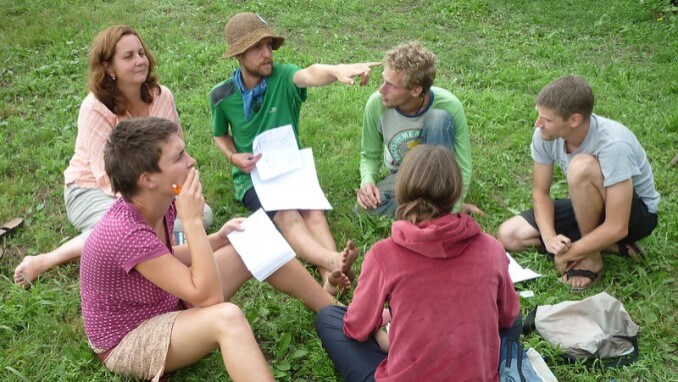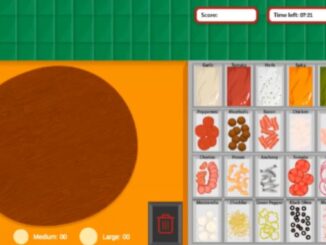
In the world of games-based learning and gamification, we frequently see research on the efficacy of using games in learning applications, or articles and posts extolling the virtues of this approach. But it stills feels like we are fighting an uphill battle to convince many people that games are ‘serious’ enough for applications in learning for adults, or that the extra time and expense involved is worth it when there are cheaper content delivery options.
Games themselves tell us that if one approach doesn’t work, we should try a different strategy in order to win. The ability to fail quickly, get timely feedback and experiment with different approaches until you get it right, are, after all, characteristics of games which makes them so suitable for learning. Maybe that is what we need to do in our efforts to raise the profile and acceptance of games-based and gamified learning.
I believe that we are approaching our arguments in favour of games-based learning (GBL) from the wrong direction.
Instead of thinking that well-designed games are great for implementing learning, we should rather be thinking that well-designed learning is a great way to make compelling games.
The Problem of Explaining Games-based Learning

The former way of presenting the argument is problematic.
It invites comparison with other methods of delivering learning. At best, games-based learning is seen as one pedagogy among many alternatives, which in turn opens up the path to objections to games-based learning. We are all familiar with these; games are for kids, it’s too expensive compared with a powerpoint deck, serious people don’t want to play games, etc.
In the face of these objections, we redouble our efforts to explain ‘Why’ – what it is that makes games so great for learning, and why it’s worth the extra time and expense. And because some of the pedagogical reasons may be a bit complex for those whose expertise lies in other fields than learning, e.g. clients, this very often this boils down to conversations about ‘engagement’.
(If the above sounds a bit patronising, think about times you have done learning design using approaches other than games-based learning. Did you have to explain Constructivism to your client when you designed a programme based on problem-based learning (PBL)?)
Nor is the ‘engagement’ conversation confined to GBL. One of the issues we face in learning as a whole is the perceived importance of ‘engagement’ as a measure of success. ‘Bums on seats’, ‘completion’ and so on, none of which measure whether learning has taken place, or evaluate the impact of that learning, still feature heavily in the KPIs of L&D departments.
Engagement in Learning

Clearly engagement is important. Learning is not going to happen if learners don’t engage with the learning you have designed. But if this is seen as the major (or even only) reason for using games in learning, then it is often not enough to convince clients to take this (often more costly, time-consuming and complex) approach. Unless they perceive that disengagement is a major issue, that they need to solve, to get their KPIs up where they want them, many clients would rather take measures such as mandating attendance. Alternatively, confusing software platforms with properly designed gamification, they stick their content up on an LMS with a leaderboard plugin, or attach courses to programmes which reward employees with doughnuts.
The engagement conversation sells games-based learning massively short, meaning that, at worst, many clients do not see GBL as a pedagogy at all, but as a gimmick, an ‘add-on’ to fix an engagement problem, which logically, if you don’t perceive you have that problem (or you can fix it in other, easier, ways), you don’t need.
Which brings us to the greatest damage that the engagement conversation does – not to games-based learning, but to learning as a whole. It implies that learning NEEDS something extra in order for learners to want to engage with it.
Work = Suffering
This, I believe, is also tied up very tightly, with the idea mentioned above, about serious people not wanting to engage with games for learning. Sadly, we have come to believe that ‘work’ should not be fun; that it is something that we have to suffer in order to have what we want in the only time that we are really allowed to enjoy – our leisure time. A staggering majority of people dislike some or all of their work, and because that is seen as the normal way of things, we tolerate (or even invite) that state of affairs. Worse than that, we disdain and push away that which could bring joy to ‘work’ because it doesn’t fit with this miserable worldview, or we even take proactive actions to remove fun from work – and we make ourselves and others even more unhappy as a result.
Workplace learning, is by definition, part of work, and so many people will distrust the potential of games-based learning to make work ‘less serious’ or to inject inappropriate ‘fun’.
Learning = Fun

Learning is Fun! And likewise, Fun is Learning. This is the basis for my claim in the opening paragraphs that we need to talk about well-designed learning being a great way to make compelling games
Think about great games, ones which you want to return to again and again. There are many characteristics that these games share which are about players learning. Let’s look more closely at some of these.
- Repeated experiences allow you to get ‘better’ at playing – Learning through Repetition and Practice (Experience (including mistakes) provides the basis for the learning activities)
- The degree of skill that a player has can be measured (e.g. by points, and ultimately by ‘winning’) – Assessment and Feedback
- Constant and timely feedback allows players to adjust their play to get closer to ‘winning’ – Formative Assessment (or Ipsative Assessment if one is competing with oneself)
- Players are able to exercise a degree of creativity in solving the ‘problem’ of winning – Autonomy and Problem-centred Learning
- Players can exercise decision making rather than following a pre-ordained path through the game – Autonomy (Adults need to be involved in the planning and evaluation of their instruction)
- Players find themselves attracted to particular games through their Aesthetics (different aspects of experience), which differ in their appeal to different players – Relevance
- Improvement in play or interaction with ever more complex gameplay experiences is positively associated with self-image (being ‘good at’ play) – Self-Concept and Adult Learning Experience
Poor Learning is Not Fun
Now let’s consider some less-good games, ones that get put aside after a few plays, because they offer less potential for ‘fun’ or enjoyment.
- Repeated experiences do not necessarily lead to you becoming a better player, maybe because the game experience is overly reliant on luck.
- A poorly designed scoring system makes it difficult to discern whether one is playing well or not at any given point in the game.
- When you make a play it is not transparently linked to its effect on the state of the game
- There are a limited number of choices that one can make to influence the progress of the game, or choices are constrained in some way, because of the current state of the game.
- Progress through the game is linear and is more like a ‘story’ that the designer expects you to follow, than an interactive experience that that the paly can have some influence over.
- Winning at the game is seen by players as trivial or not a matter of pride, again, maybe because it is simply a matter of chance and does not reflect individual skill.
Let’s do a little thought experiment

Many of you reading this will be games-based learning professionals. Let’s step into an alternative reality, where instead of being tasked with creating great learning, using games as your building blocks, your job is creating compelling games (or simply ‘fun’), and ‘learning’ is the raw material you have to work with.
Remember as you read this that the learning is not the point, so we have no need to use ‘related’ learning activities, in just the same way that if you were using games to create learning experiences, you wouldn’t feel compelled to make all your gameful activities the same (using the same mechanics regardless of the learning outcome). In fact you would probably want to use variety to maintain your learners’ interest.
Just like there are lots of different learning theories and models you could use when designing a learning programme, there are theories of fun and ludology (unfortunately not as many as there are learning theories, but there’s folk working on that).
A Fun Framework to Inform Learning Design
To pick just one that we will work with to create our Fun experience, let’s work with Nicole Lazzaro’s Four Keys to Fun. She posits four different kinds of Fun:
- Easy Fun (Novelty): Curiosity from exploration, role play, and creativity
- Hard Fun (Challenge): Fiero, the epic win, from achieving a difficult goal
- People Fun (Friendship): Amusement from competition and cooperation
- Serious Fun (Meaning): Excitement from changing the player and their world
To create Easy Fun, we could introduce our players to a new domain of knowledge skills or values. This will engender curiosity, and potentially also allow for some Hard Fun, too, if the new concepts are challenging. Creativity can be stimulated by inviting players to make artifacts, tell stories (including empathic stories told from the point of view of the other).
Allow your players to make their own choices about how they learn; the order in which they access content, how they process it, the strategies they use, and the outputs they produce.
Invite them to carry out learning activities with others to bring out the People Fun – joint research projects, action learning sets. Combine People Fun with Challenge with comparative assessment. Social Learning activities such as curation with social sharing allow players to derive pleasure from give recognition to other, and of receiving it.
Obstacles can be Great for Learning

Don’t fall into the trap of making learning ‘easy’, thinking that it will make it more likely to ‘stick’. The opposite is likely to be the case, as players will become bored and disengage, if they do not feel challenged. They will never achieve the feeling of Fiero, if the road to achievement does not feel meaningful.
Maybe counter-intuitively, to some, when faced with the choice to remove ‘blockers’ to learning or creating more ‘unnecessary obstacles’, we should take the latter route.
Playing a game is a voluntary attempt to overcome unnecessary obstacles
Bernard Suits – The Grasshopper: Games, Life and Utopia (1978)
The Grasshopper by Bernard Suits is available on Amazon
Serious Fun focuses on the satisfaction we derive from knowing that we can have an impact, on ourselves and the world. For learning to give us this kind of fun, it has to matter. This is related to the one of the principles of Knowles’ Andragogy – that learners need to see relevance (and the facilitation of impact) in what they are learning. When designing learning for serious fun, we must either choose topics that are already of interest to the learner in this way, or we need to make it explicit how the learning COULD be relevant and impactful, if that is not immediately obvious to the learner.
The Adult Learner by Malcolm Knowles is available on Amazon
Learning for all these different kinds of fun needs to be underpinned with systems to measure and feedback, regularly, so that the learner can perceive achievement, social capital, and impact, and so that they can change their strategies to maintain (or improve) these to keep the fun going. This requires the use of well-designed assessment and evaluation instruments.
Games for Learning
But we don’t live in this alternative universe, and when clients come to us, they are interested in the learning, not the fun and games. Indeed, it’s often an uphill struggle to convince them that games are the way to go at all.
So, what is the use of this thought experiment, and how can it feed into our games-based learning practice?
Perhaps the most important thing we can take from the above is a change in (our own) mindset. If we accept that games (or fun) and learning are one and the same thing, we can start to approach how we think about the learning outcomes we are designing to, very differently.
Instead of making the assumption that learning is inherently boring and unpalatable, and that learners have to be coaxed (or even tricked) to engage, we can take an altogether more optimistic approach. We can assume that if learners are learning, then they are having fun, and then set about finding the design that will make the fun of any specific outcome explicit (because we can be sure that design exists).
Ironically, many of the things that we do to make ‘boring’ learning (compliance training is an often cited example) more palatable, sucks the fun right out of it.
The Mistake of Making Learning Easy

We try to make it less challenging, so people can complete it quicker, and because we conflate ‘ease of use’ with ease of learning. We make completion the main objective, ensuring that there will be no Fiero.
Our ambitions for what constitutes ‘learning’ in these cases is pared back, in part because we don’t want to make people have to spend more time than necessary on such a ‘boring’ topic – so social activities, reflection and so on is kept to a minimum. We strip everything back to basic principles, creating the same standardised route for all, totally removing all individual relevance, as well as autonomy or creativity in individual approaches.
Think of Fun First – Not an Afterthought
The whole exercise creates a self-fulfilling prophecy. Once the ‘learners’ have ticked all the boxes, they have fulfilled all the legal requirements but no learning (and therefore no fun) has taken place, and it is all the most boring experience most people can imagine.
And then to ‘fix’ the issue of boredom, and its effects, such as attrition, we turn to ‘gamification’ as a veneer applied after the event, adding ‘rewards’ which are extrinsic to the learning itself, which can further erode the perception of the learning being rewarding (or fun) in its own right.
Such ‘learning’ is, often literally, a ‘box-ticking’ exercise (‘nuggets’ of content followed by multiple choice assessment is often a favoured format). Learners often forget instantly what they have ‘learned’ – and small wonder, because if they had actually learned, they would have had fun.
Obviously, as learning designers we need to start with what our learners need to learn, but I would argue, our very next step should be to think about where the fun is in those outcomes. We may end up designing an actual game, or we may design something that although not actually a game, will certainly be playful, and contain many characteristics that are shared by games and gameful experiences.
Fun is just another word for learning
Ralph Koster – A Theory of Fun for Game Design
A Theory of Fun for Games Design is available on Amazon
- James Bore – The Ransomeware Game - 13th February 2024
- Ipsodeckso – Risky Business - 23rd January 2024
- Review – Luma World Games - 15th December 2023





Be the first to comment